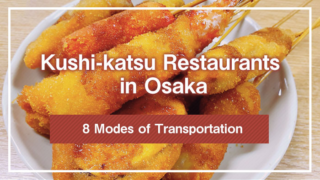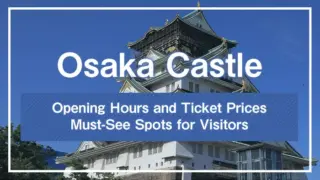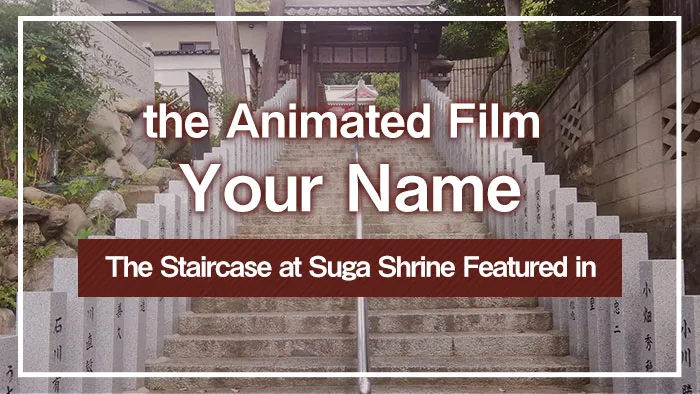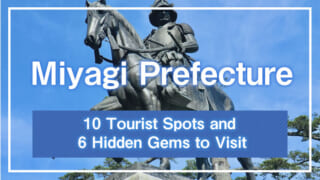Are you familiar with the animated film Your Name. (Kimi no Na wa.)? This fantasy story, set in Japan before and after a comet collision, tells the tale of a boy and girl whose souls swap bodies. The film captured the hearts of many and became a cultural phenomenon.
One of the most memorable locations from the movie is the staircase at Suga Shrine in Yotsuya, Tokyo. Featured prominently during the film’s climactic scene, the staircase is where the protagonists, Taki and Mitsuha, reunite in a deeply symbolic moment. After the movie’s release, this staircase became a well-known pilgrimage site for fans. Its red railings and the pathway extending beyond the base of the stairs leave a lasting impression, making it a must-visit spot for anyone who has seen the film.
In this article, we’ll introduce the staircase at Suga Shrine, recognized as a significant site from Your Name., as well as ideas to help you make the most of your visit to the shrine.
1.The Iconic Suga Shrine Staircase from the Animated Film Your Name.
Your Name. is an animated film directed by Makoto Shinkai and released in 2016. The movie became a massive hit not only in Japan but worldwide, praised for its stunning visuals and poignant love story. It is regarded as one of the most significant works in the history of Japanese animation.
Among the film’s many memorable scenes, the staircase at Suga Shrine in Yotsuya, Tokyo, holds a special place. This staircase served as the stage for the climactic and emotional reunion of the protagonists, Taki and Mitsuha, in the film’s finale. Following the movie’s release, this location has become a popular pilgrimage site for fans. Walking up and down the staircase allows visitors to immerse themselves in the film’s atmosphere.
The striking red railings and unique design of the staircase make it a highly photogenic spot.
1-1.History of Suga Shrine
Suga Shrine is a historical shrine beloved by the community, with roots tracing back to the early Edo period.
Originally established as an Inari Shrine in the Akasaka area, it was relocated to its current site in Yotsuya due to construction projects around the Edo Castle’s outer moat. Later, the shrine began enshrining Susanoo-no-Mikoto, a Shinto deity, and gained popularity under the name Yotsuya Tenno-sha. During the Meiji period, it was renamed Suga Shrine and was elevated to the status of a Gōsha (village shrine). Post-WWII reforms abolished the old shrine rankings, but Suga Shrine has retained its cultural significance.
The name “Suga” comes from a myth involving Susanoo-no-Mikoto, who, after defeating the Yamata-no-Orochi serpent in Izumo, declared, “I feel soothed and refreshed in this land” (吾れ此の地に来たりて心須賀、須賀し). This phrase conveys a sense of peace and comfort, which is reflected in the shrine’s name.
Suga Shrine enshrines several deities, including:
Susanoo-no-Mikoto: Worshiped as the god of civil engineering and protection from evil.
Uka-no-Mitama-no-Kami (Inari Ōkami): Revered as the deity of agriculture and business prosperity.
During the Edo period, the shrine’s festivals, such as the Tenno Matsuri and Kappa Matsuri, were well-known and deeply cherished by the local community.
Unfortunately, the shrine buildings were destroyed during wartime air raids. The current structures were rebuilt as part of post-war recovery efforts.
1-2.Access to Suga Shrine
Suga Shrine is easily accessible from multiple train stations and routes.
By Train:
From JR Yotsuya Station or JR Shinanomachi Station, it’s about a 10-minute walk.
If using the Tokyo Metro, it’s a 10-minute walk from Yotsuya Station on the Marunouchi or Namboku Lines, or a 7-minute walk from Yotsuya-Sanchome Station on the Marunouchi Line.
Access Routes:
There are five main routes to reach the shrine:
From the corner near Lawson Store 100 at Yotsuya 2-Chome.
From the pathway beside Mitsui Real Estate Rehouse.
Via the side of Edo-Mae Bikkuri Sushi.
From the Samoncho traffic signal on Gaien Higashi-dori Avenue.
Through the side of Tanabe Milk Shop at Wakaba 2-Chome.
By Car:
Vehicles can only access the shrine via the route from the Samoncho traffic signal on Gaien Higashi-dori Avenue. Suga Shrine provides a parking lot for visitors, but be aware that other routes are restricted to pedestrian use due to stairs or traffic limitations.
2. Ideas for Enjoying Suga Shrine
Suga Shrine is a captivating blend of history and modernity. The stately main hall, with its origins in the Edo period, is a must-see. Take the time to carefully observe its architecture, carvings, and other intricate details.
Below are four suggestions to help you fully enjoy your visit to Suga Shrine.
2-1.Take a Commemorative Photo on the “Otokozaka” Staircase
The “Otokozaka” staircase at Suga Shrine gained fame as a key location in the movie Your Name., making it a popular photography spot for visitors. The red railings and the elegant design of the steps are especially photogenic.
Photography Tips:
Capture the entire staircase to highlight the grand scale of the location.
Include people walking or standing on the stairs to add a sense of life and context to your photos.
Photography Etiquette:
Be mindful of other visitors and maintain a quiet and respectful atmosphere while taking photos.
Remember to take your trash away with you and help preserve the beautiful environment.
The Otokozaka staircase is not only a visual treat but also a way to connect with the iconic scene from Your Name., making it a must-visit for fans and photography enthusiasts alike.
2-2.Offer Prayers at Suga Shrine
Suga Shrine is a historic place of worship, enshrining many deities. Through prayer, visitors can cleanse their mind and body while expressing their hopes and gratitude.
Proper Etiquette for Worship:
When passing through the torii gate, walk along the center path and bow slightly to show respect to the deities.
At the purification fountain (temizuya), cleanse your hands and mouth:
1. Rinse your right hand, then your left hand.
2. Use your right hand to pour water into your left hand and rinse your mouth (do not drink directly from the ladle).
3. Hold the ladle upright to clean it, and return it to its place.
During prayer, ring the bell, offer coins at the offering box, perform two bows, clap your hands twice, and bow one final time. Make your prayer silently in your heart.
2-3.Collect Goshuin Stamps and Ema Plaques
At Suga Shrine, visitors can obtain goshuin stamps and ema plaques as unique mementos of their visit.
Goshuin: A goshuin is a handwritten seal, often accompanied by elegant calligraphy, that signifies your visit to the shrine. Each shrine has a distinct design, making goshuin collecting a popular and meaningful activity for enthusiasts.
Ema: Ema are small wooden plaques on which you can write your wishes or prayers. These plaques are then hung on designated racks within the shrine grounds. Typically adorned with artwork or symbols of the shrine, ema offer a tangible way to connect with the spiritual and cultural traditions of Japan.
Both goshuin and ema provide a special way to commemorate your visit while engaging in traditional Japanese practices.
2-4.Try an Omikuji Fortune
Drawing an omikuji fortune slip is one of the enjoyable aspects of visiting a shrine. These fortunes not only reveal your luck (ranging from great blessings to bad luck) but often include advice or words of encouragement to guide your path.
How to Use Omikuji:
・Draw only one omikuji per visit, as it represents the message meant for you at that moment.
・Reflect on its guidance and take it to heart.
・After reading, you can either keep it as a personal token or tie it to the designated rack at the shrine as a symbolic gesture of releasing the fortune back to the gods.
This small ritual allows for introspection and adds a fun, thoughtful element to your shrine experience.
3.Highlights Beyond the Suga Shrine Staircase
While the staircase at Suga Shrine is an iconic spot representing the movie Your Name., Tokyo offers many other locations where you can immerse yourself in the film’s atmosphere. Visiting these alongside Suga Shrine will deepen your appreciation of the movie’s world.
3-1.The National Art Center, Tokyo
In Your Name., Taki and his co-worker, Ms. Okudera, visit the café at the National Art Center, Tokyo during their date.
This museum not only features exhibitions by globally renowned artists but also hosts a variety of special exhibits throughout the year. The architecture of the museum itself is striking and worth admiring.
For a memorable experience, stop by the café Salon de Thé ROND, located within the art center, to enjoy the ambiance featured in the film.
3-2.Yotsuya Station
Yotsuya Station serves as the meeting point for Taki and Ms. Okudera during their date in Your Name., specifically at the Akasaka Exit.
Located in a highly convenient area with easy access to major districts like Shinjuku and Shibuya, Yotsuya Station is a hub of activity. The surrounding area boasts numerous dining establishments and commercial facilities, offering opportunities for shopping and enjoying a variety of cuisines.
3-3. Tōfukuin-zaka (Tennō-zaka)
Tōfukuin-zaka, or Tennō-zaka, appears in a scene where Mitsuha is seen climbing the hill.
This quiet, cobblestone slope is located near Suga Shrine and exudes a nostalgic charm, with traditional townhouses lining the pathway. It’s a serene and picturesque spot, making it popular as a walking route.
3-4. Entsūji-zaka
Entsūji-zaka is featured in the movie when Taki runs down the hill toward Tōfukuin-zaka.
Like Tōfukuin-zaka, this slope offers a tranquil, old-fashioned atmosphere. Along the way, you’ll find Entsūji Temple, known for its beautifully maintained gardens that are open for exploration. Additionally, the slope is dotted with chic cafes and boutique shops, making it an excellent destination for a leisurely stroll.
Conclusion
The staircase at Suga Shrine, where the emotional reunion of Taki and Mitsuha takes place in the film Your Name., has become a sacred spot for anime fans worldwide.
For international visitors interested in Japanese anime culture or traditional shrine experiences, this location is especially appealing. Its convenient location in central Tokyo makes it easily accessible.
Consider adding Suga Shrine to your Tokyo itinerary. With its proximity to Yotsuya Station, you can seamlessly explore other popular destinations such as Shinjuku, Shibuya, Harajuku, and Ikebukuro.
*This article is based on information available as of November 2024.
























